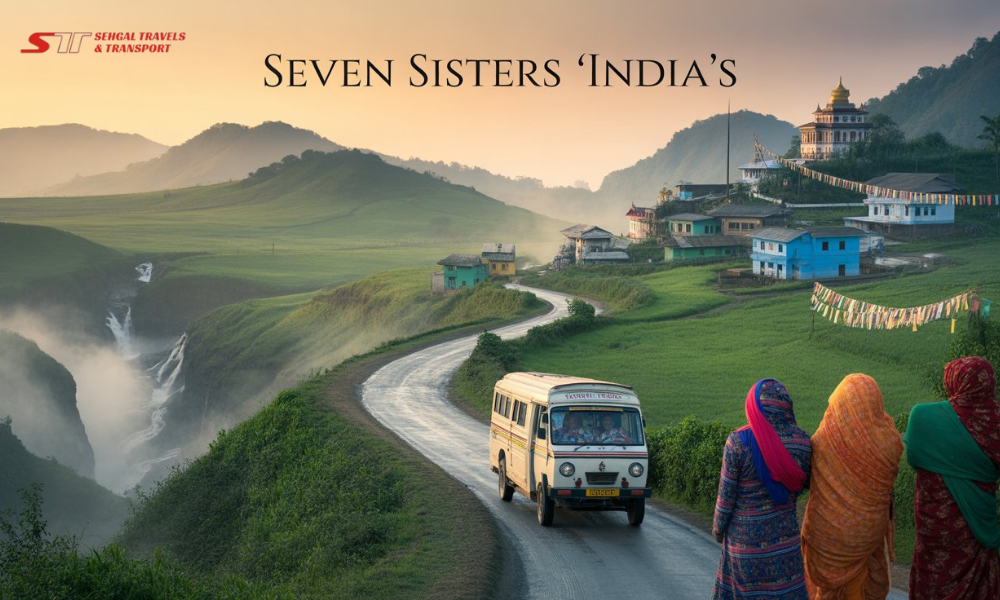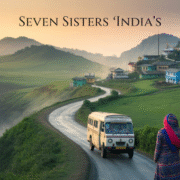
Why Do Travelers Call the Seven Sisters ‘India’s Best-Kept Secret’?
You’ve probably scrolled past a hundred photos of the Taj Mahal, right? Maybe you’ve seen the backpacker trail through Goa or the spiritual seekers flooding Rishikesh. But have you heard much about India’s northeastern corner—the Seven Sisters? If your answer is “not really,” you’re exactly proving the point. This stunning cluster of seven states is what travelers whisper about in hostel common rooms, the kind of place that makes you feel like you’ve discovered something truly special.
What Exactly Are the Seven Sisters?
Let’s get the basics straight first. The Seven Sisters refer to seven northeastern states of India: Arunachal Pradesh, Assam, Meghalaya, Manipur, Mizoram, Nagaland, and Tripura, named by journalist Jyoti Prasad Saikia during a radio talk show in January 1972. Together, they form about 8% of India’s total landmass but hold way more than 8% of its charm.
The region is nestled between the Himalayas and the plains of Bangladesh and Myanmar, making it geographically distinct from mainland India. Think rolling green hills, mist-covered valleys, thundering waterfalls, and Buddhist monasteries perched on mountain peaks — best explored comfortably with a tempo traveller, perfect for long, scenic drives across these breathtaking landscapes. It’s a completely different vibe from what most people picture when they imagine India.
Why “Best-Kept Secret”? The Mystery Explained
Geography Creates Natural Isolation
Here’s the thing—these states aren’t exactly easy to reach. The Seven Sisters are connected to the rest of India through the narrow Siliguri Corridor, also known as the ‘Chicken Neck’. This geographical bottleneck means fewer tourists accidentally wander in. You have to actually want to go there, which naturally keeps the crowds down.
The region borders China’s Tibetan region, Myanmar, Bangladesh, Bhutan, and Nepal, giving it more in common culturally with Southeast Asia and the Himalayas than with the typical Indian tourist circuit. This creates a fascinating cultural blend that feels refreshingly different.
Historical and Political Context
Let me be honest—there’s a reason this region remained under the radar for so long. The Seven Sisters were considered unsafe until the early 2000s due to inter-tribal tensions, insurgencies, and disputed borders with China, with some areas being closed-off combat zones. That reputation, even though the situation has dramatically improved, still lingers in people’s minds.
Some states including Arunachal Pradesh, Nagaland, and Mizoram require special permits for entry, with Indian citizens needing an Inner Line Permit and foreign nationals requiring a Protected Area Permit. While this might sound like a hassle (and okay, it kind of is), it also acts as a natural filter that keeps mass tourism at bay.
Underdeveloped Tourism Infrastructure
The Seven Sisters are quite undeveloped when it comes to tourism, making this destination best suited for open-minded and adventurous travelers. You won’t find the same level of tourist infrastructure here as you would in Rajasthan or Kerala. Hotels might be basic, roads can be challenging (especially during monsoons), and English isn’t as widely spoken as in other parts of India.
But here’s where it gets interesting—this “underdevelopment” is actually part of the appeal. When you plan a trip through providers like Sehgal Travels, you’re getting access to authentic experiences rather than sanitized tourist versions.
Mind-Blowing Diversity That Nobody Talks About
There are 220 languages spoken in Northeast India, with the region famous for its ethnic, cultural and tribal diversity, featuring languages from Indo-Aryan, Dravidian, Austric and Sino-Tibetan language families. Let that sink in for a moment. Two hundred and twenty languages in a region that most Indians themselves haven’t fully explored.
The region is home to over 200 ethnic tribes, each with its own traditions, rituals, and festivals. This isn’t just “diverse” in the tourism brochure sense—this is genuinely mind-blowing cultural variation packed into a relatively small geographical area.
What Makes Each Sister Special
Assam: The Gateway Everyone Rushes Through
Assam is famous for its world-class tea estates and Kaziranga National Park, a UNESCO World Heritage Site home to the one-horned rhinoceros. Most travelers use Guwahati as their entry point and then rush off to other states, but Assam deserves more love. Majuli, the world’s largest river island, is a hub of Vaishnavite culture and feels like stepping back in time.
Meghalaya: Where Clouds Live
Meghalaya literally translates to ‘abode of clouds’ and receives plenty of rain throughout the year, resulting in lush greenery and abundant water bodies. The living root bridges, especially in Nongriat village, are architectural marvels where tree roots are trained over decades to form functional bridges. I mean, come on—bridges made from living trees? That’s straight out of a fantasy novel.
Arunachal Pradesh: India’s Easternmost Mystery
Often called the “Land of the Rising Sun,” Arunachal Pradesh is the least traveled state among the Seven Sisters and therefore considered a hidden gem. Tawang Monastery is one of the largest monasteries in India, offering breathtaking views of the Himalayas. The state also hosts India’s least-known but most amazing music festival in Ziro Valley, where different tribes celebrate their common love for music.
Nagaland: Festival Central
Nagaland is known for its vibrant tribal culture and the famous Hornbill Festival, offering fascinating insight into indigenous traditions. Each of Nagaland’s 16 major tribes has unique customs, songs, and dances. The Dzukou Valley with its seasonal blooms is another highlight that photographers dream about.
The Smaller Sisters: Manipur, Mizoram, and Tripura
These three might be smaller, but they pack a punch. Manipur’s name literally means ‘city of jewels,’ and it houses Loktak Lake, the largest freshwater lake in India. Mizoram’s high hills and serene culture enchant travelers, while Tripura boasts royal palaces like Neermahal.
The Raw, Unfiltered Experience
What really sets the Seven Sisters apart is the authenticity. Unlike more commercialized Himalayan states, this part of India offers travelers raw authenticity. When you stay in a homestay here, you’re genuinely staying with a family, not in a commercialized “homestay experience.” When you attend a festival, you’re celebrating alongside locals, not watching a performance staged for tourists.
Tourism here is often community-driven, allowing for genuine interactions and a deeper understanding of the local ethos, with a strong emphasis on sustainable practices making it ideal for eco-conscious travelers. This community-based approach means your travel actually benefits local people directly, which feels good if you care about responsible tourism.
The Challenges That Keep It “Secret”
Permit Bureaucracy
Let’s not sugarcoat it—getting permits can be annoying. Different states have different requirements, rules change, and the process isn’t always straightforward. It’s important to check the latest permit requirements before planning your trip. Working with experienced tour operators like Sehgal Travels can help navigate this bureaucracy smoothly.
Limited Connectivity
Guwahati in Assam is the primary gateway to the Northeast, with direct flights to most state capitals, while train travel within the region is limited but being expanded. The road network exists but quality varies significantly. Some remote areas become completely inaccessible during monsoon season when roads get washed out.
The Perception Problem
Even with improved safety, many potential travelers still carry outdated perceptions about the region being unsafe or too difficult to navigate. The region felt perfectly safe for solo female travelers, though common-sense precautions are always advisable. The reality is that you’re probably as safe here as anywhere else in India, but breaking through those mental barriers takes effort.
Weather Windows
While the best time to visit varies by state, October to April is generally the best period for travel, avoiding the monsoon season which can make travel difficult. This relatively narrow weather window compared to other Indian destinations means tourism remains seasonal and limited.
What Travelers Say Online
Scrolling through travel forums and social media, you’ll find passionate testimonials from people who’ve visited. They describe feeling like they’ve stepped into a completely different country. The recurring themes? Pristine nature, warm hospitality, cultural richness, and that addictive feeling of being somewhere genuinely special that hasn’t been overrun yet.
One traveler noted that Northeast India feels more connected to Southeast Asian culture than typical Indian mainland culture—from the food (hello, momos and pork dishes) to the faces you see to the traditional clothing. Another mentioned the surreal experience of being the only tourist at major attractions, something increasingly rare in India.
My Limited Understanding (And What’s Still Unclear)
Full disclosure—I’m working with secondhand information here, drawing from travel guides, blogs, and online discussions. I haven’t trekked through Dzukou Valley myself or attended the Hornbill Festival in person. What I can’t tell you is how it feels to wake up in a Naga village homestay or what the air smells like in Meghalaya after rain (probably amazing, but that’s speculation).
What also remains somewhat unclear is how quickly things are changing. Tourism infrastructure is developing, social media is spreading the word, and more travelers are discovering the region. Some articles suggest it’s “opening up,” while others maintain it’s still gloriously untouched. The reality is probably somewhere in between and varies significantly from state to state.
Looking Ahead: Will It Stay Secret?
Here’s the million-dollar question: how long can the Seven Sisters remain India’s best-kept secret? The answer is complicated.
On one hand, improved infrastructure, easier permits, and social media exposure will inevitably bring more tourists. The Indian government is actively promoting Northeast tourism. Airlines are adding routes. Roads are improving. The “secret” is slowly leaking out.
On the other hand, the region’s inherent challenges—geography, weather, permit requirements, cultural sensitivity—will likely prevent it from ever becoming another Goa or Rajasthan. There’s only so much you can scale certain experiences. You can’t exactly turn a remote Arunachal Pradesh monastery into a theme park without destroying what makes it special.
The future probably looks something like this: steadily increasing but still manageable tourism, with the region attracting travelers who genuinely want to be there rather than casual tourists ticking boxes. Working with responsible operators like Sehgal Travels who understand the delicate balance between accessibility and preservation will become increasingly important.
What’s still beautifully unclear is which parts will remain pristine and which will transform. Will Meghalaya’s living root bridges survive an Instagram boom? Will Nagaland’s festivals maintain their authenticity as more outsiders attend? These questions don’t have answers yet, and that uncertainty is part of what makes the region so intriguing.
The Seven Sisters aren’t a “secret” in the true sense—they’re right there on the map, documented online, and accessible to anyone willing to make the effort. But they remain delightfully unknown to the masses, offering that rare combination of stunning beauty, rich culture, and genuine authenticity that’s increasingly hard to find in our over-touristed world. Whether that remains true five or ten years from now? Well, that’s a story still being written.
Frequently Asked Questions
Q: Is it safe to travel to the Seven Sisters as a solo traveler?
A: Yes, the region is generally safe for solo travelers, including women. While some areas had security concerns in the past, the situation has improved significantly since the early 2000s. Standard travel precautions apply—respect local customs, dress conservatively, and stay informed about any specific regional advisories.
Q: Do I need special permits to visit the Seven Sisters?
A: Some states require permits. Arunachal Pradesh, Nagaland, and Mizoram need an Inner Line Permit (ILP) for Indian citizens and a Protected Area Permit (PAP) for foreign nationals. Assam, Meghalaya, Tripura, and Manipur generally don’t require special permits. Requirements can change, so check current regulations before traveling.
Q: When is the best time to visit the Northeast?
A: October to April is generally ideal, with pleasant weather and clear skies. This period avoids the heavy monsoon season (June-September) when landslides and flooding can make travel difficult. However, specific festivals like the Hornbill Festival (early December) or Bihu (April) might influence your timing.
Q: How do I reach the Seven Sisters from other parts of India?
A: Guwahati in Assam is the main entry point, with regular flights from major Indian cities. From Guwahati, you can take flights to other state capitals or travel by road. Train connectivity exists but is limited. Most travelers either join organized tours or hire private vehicles for better flexibility across the region.




